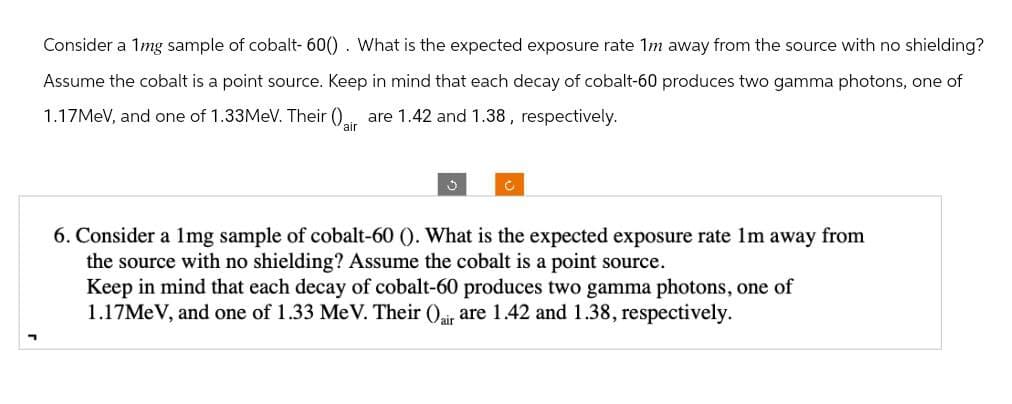Consider a 1mg sample of cobalt- 60(). What is the expected exposure rate 1m away from the source with no shielding? Assume the cobalt is a point source. Keep in mind that each decay of cobalt-60 produces two gamma photons, one of 1.17MeV, and one of 1.33MeV. Their () air are 1.42 and 1.38, respectively. ? c 6. Consider a 1mg sample of cobalt-60 (). What is the expected exposure rate 1m away from the source with no shielding? Assume the cobalt is a point source. Keep in mind that each decay of cobalt-60 produces two gamma photons, one of 1.17MeV, and one of 1.33 MeV. Their (air are 1.42 and 1.38, respectively.
Consider a 1mg sample of cobalt- 60(). What is the expected exposure rate 1m away from the source with no shielding? Assume the cobalt is a point source. Keep in mind that each decay of cobalt-60 produces two gamma photons, one of 1.17MeV, and one of 1.33MeV. Their () air are 1.42 and 1.38, respectively. ? c 6. Consider a 1mg sample of cobalt-60 (). What is the expected exposure rate 1m away from the source with no shielding? Assume the cobalt is a point source. Keep in mind that each decay of cobalt-60 produces two gamma photons, one of 1.17MeV, and one of 1.33 MeV. Their (air are 1.42 and 1.38, respectively.
Chemistry: The Molecular Science
5th Edition
ISBN:9781285199047
Author:John W. Moore, Conrad L. Stanitski
Publisher:John W. Moore, Conrad L. Stanitski
Chapter18: Nuclear Chemistry
Section: Chapter Questions
Problem 18.CCP
Related questions
Question

Transcribed Image Text:Consider a 1mg sample of cobalt- 60(). What is the expected exposure rate 1m away from the source with no shielding?
Assume the cobalt is a point source. Keep in mind that each decay of cobalt-60 produces two gamma photons, one of
1.17MeV, and one of 1.33MeV. Their () air are 1.42 and 1.38, respectively.
?
c
6. Consider a 1mg sample of cobalt-60 (). What is the expected exposure rate 1m away from
the source with no shielding? Assume the cobalt is a point source.
Keep in mind that each decay of cobalt-60 produces two gamma photons, one of
1.17MeV, and one of 1.33 MeV. Their (air are 1.42 and 1.38, respectively.
Expert Solution
This question has been solved!
Explore an expertly crafted, step-by-step solution for a thorough understanding of key concepts.
Step by step
Solved in 2 steps

Recommended textbooks for you

Chemistry: The Molecular Science
Chemistry
ISBN:
9781285199047
Author:
John W. Moore, Conrad L. Stanitski
Publisher:
Cengage Learning

Introductory Chemistry: An Active Learning Approa…
Chemistry
ISBN:
9781305079250
Author:
Mark S. Cracolice, Ed Peters
Publisher:
Cengage Learning

Chemistry: Principles and Reactions
Chemistry
ISBN:
9781305079373
Author:
William L. Masterton, Cecile N. Hurley
Publisher:
Cengage Learning

Chemistry: The Molecular Science
Chemistry
ISBN:
9781285199047
Author:
John W. Moore, Conrad L. Stanitski
Publisher:
Cengage Learning

Introductory Chemistry: An Active Learning Approa…
Chemistry
ISBN:
9781305079250
Author:
Mark S. Cracolice, Ed Peters
Publisher:
Cengage Learning

Chemistry: Principles and Reactions
Chemistry
ISBN:
9781305079373
Author:
William L. Masterton, Cecile N. Hurley
Publisher:
Cengage Learning

Chemistry & Chemical Reactivity
Chemistry
ISBN:
9781337399074
Author:
John C. Kotz, Paul M. Treichel, John Townsend, David Treichel
Publisher:
Cengage Learning

Chemistry by OpenStax (2015-05-04)
Chemistry
ISBN:
9781938168390
Author:
Klaus Theopold, Richard H Langley, Paul Flowers, William R. Robinson, Mark Blaser
Publisher:
OpenStax

Chemistry: An Atoms First Approach
Chemistry
ISBN:
9781305079243
Author:
Steven S. Zumdahl, Susan A. Zumdahl
Publisher:
Cengage Learning